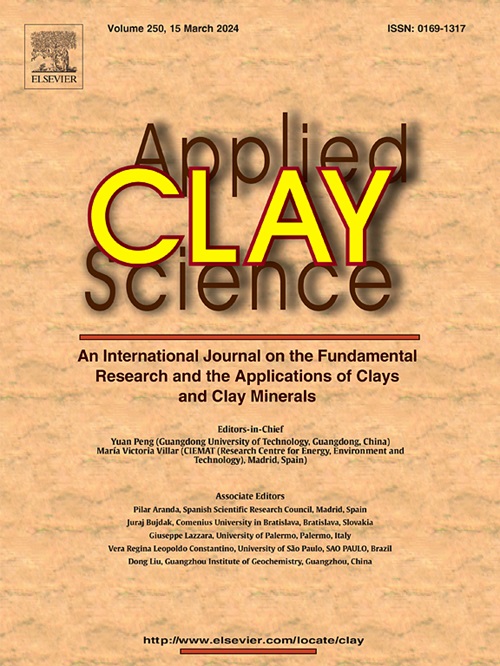Molecular-scale insights into retention and aggregation of organophosphate esters (OPEs) with clay-organic complexes
IF 5.3
2区 地球科学
Q2 CHEMISTRY, PHYSICAL
引用次数: 0
Abstract
Clay-organic complexes, as the major substrate in surface environment, play an essential role in the retention of organophosphate esters (OPEs). Due to the complexity and heterogeneity of clay-organic aggregates, the molecular-level understanding of the interactions between OPEs and clay-organics has not been elucidated. This work systematically investigates the dynamic retention and aggregation behavior of three types of OPEs (TBEP, TCEP and TCP) with kaolinite-organic complexes by molecular dynamic (MD) simulations and density function theory (DFT) calculations. Flexible (SRFA) and rigid (WFA) molecular structures of organic matters are considered. Results demonstrate that both SRFA and WFA can act as bridges to connect the hydroxyl surface of kaolinite and OPE aggregates. The flexible SRFAs tend to fold themselves, thereby providing hydrophobic sites for OPEs. The aggregates of WFA are divided into several parts and attach to outer surface of the OPE polymers, as the rigid WFA cannot undergo conformational changes. According to DFT results, OPE oligomerization is primarily driven by vdW interaction attributed to their typical hydrophobic nature, supplemented by weak electrostatic forces from minor hydrophilic moieties. This work reveals that the transport and bioavailability of OPEs are significantly reduced by forming OPE-NOM-kaolinite co-aggregates, and provides a quantitative understanding of the environmental processes of OPEs at the molecular and electronic scales.

有机磷酯(OPEs)与粘土-有机配合物的保留和聚集的分子尺度见解
粘土-有机配合物作为表面环境中的主要底物,在有机磷酸酯(OPEs)的滞留中起着至关重要的作用。由于粘土-有机聚集体的复杂性和非均质性,在分子水平上理解OPEs与粘土-有机物之间的相互作用尚未得到阐明。本文通过分子动力学(MD)模拟和密度泛函理论(DFT)计算,系统地研究了三种OPEs (TBEP、TCEP和TCP)在高岭石-有机配合物中的动态保留和聚集行为。有机物质的柔性(SRFA)和刚性(WFA)分子结构。结果表明,SRFA和WFA都可以作为高岭石羟基表面与OPE聚集体之间的桥梁。柔性srfa倾向于自我折叠,从而为OPEs提供疏水位点。由于刚性WFA不能发生构象变化,WFA的聚集体被分成几个部分并附着在OPE聚合物的外表面。根据DFT结果,OPE寡聚化主要是由其典型疏水性的vdW相互作用驱动的,辅之以少量亲水性部分的弱静电力。本研究揭示了OPEs的运输和生物利用度通过形成OPEs - no -高岭石共聚集体而显著降低,并提供了在分子和电子尺度上对OPEs环境过程的定量理解。
本文章由计算机程序翻译,如有差异,请以英文原文为准。
求助全文
约1分钟内获得全文
求助全文
来源期刊

Applied Clay Science
地学-矿物学
CiteScore
10.30
自引率
10.70%
发文量
289
审稿时长
39 days
期刊介绍:
Applied Clay Science aims to be an international journal attracting high quality scientific papers on clays and clay minerals, including research papers, reviews, and technical notes. The journal covers typical subjects of Fundamental and Applied Clay Science such as:
• Synthesis and purification
• Structural, crystallographic and mineralogical properties of clays and clay minerals
• Thermal properties of clays and clay minerals
• Physico-chemical properties including i) surface and interface properties; ii) thermodynamic properties; iii) mechanical properties
• Interaction with water, with polar and apolar molecules
• Colloidal properties and rheology
• Adsorption, Intercalation, Ionic exchange
• Genesis and deposits of clay minerals
• Geology and geochemistry of clays
• Modification of clays and clay minerals properties by thermal and physical treatments
• Modification by chemical treatments with organic and inorganic molecules(organoclays, pillared clays)
• Modification by biological microorganisms. etc...
 求助内容:
求助内容: 应助结果提醒方式:
应助结果提醒方式:


